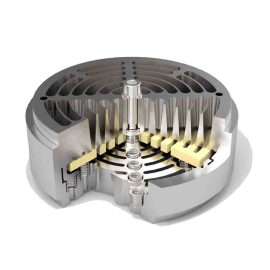Concentric Valves at the same time carry out the suction and discharge function, deriving from the combination of the different types of single acting valves.
The suction side can be provided with plunger to install the actuator for the unloading of the compressor.
They can be in different sizes to an external diameter of 390 mm and they equip air or process gas compressors.
Compressor Concentric Valve
Concentric valves are used for oil-lubricated and oil-free compressors
Small clearance volume, so as to achieve the best output volume
Low flow resistance
Compact, space-saving design
In the concentric valve, the suction and discharge parts are integrated in the same valve body. This enables the compressor to adopt a very compact design. In order to obtain the ideal valve/cylinder head structure, the concentric valve can be specially customized according to customer requirements.
Concentric valves control the flow of gases or fluids through the compressor. When the pressure on the inlet side exceeds the pressure on the outlet side, the rings or discs lift off their seats, allowing flow. When the pressure differential drops, the springs close the rings or discs, stopping the flow.
Sealing:
The design ensures a reliable seal to prevent backflow of gas or fluid, which is critical for maintaining the efficiency and performance of the compressor.
Pressure Management:
By controlling the opening and closing based on pressure differentials, concentric valves help manage and stabilize the pressure within the compressor system.
- Fast availability and low stock in a plant with several compressors with different speeds
- Pre-defined by cylinder configuration and gas composition
- Valves are available with metallic and non-metallic plates
- Easy to assemble and disassemble
- Lowest possible leakage rates thanks to a proprietary surface refinement
- Unequaled valve/spring plate lifetime through careful material selection and special heat treatment
| Compressor speed | max. 1’500 rpm |
| Pressure difference | max. 250 bar / 3’626 psi |
| Temperature range | from –40 to +250 °C / –40 to +482 °F |
| Diameter dimensions | min. 60 mm / 2.36 in, max. 250 mm / 9.84 in |
Design and Structure
Concentric Rings/Discs:
The valve consists of a series of concentric rings or discs arranged in a layered fashion. These rings or discs open and close to allow or restrict flow. The concentric arrangement means that the pathways for gas or fluid are evenly distributed around the valve center.
Valve Seat:
The valve seat is the surface against which the concentric rings or discs seal when closed. The precise machining of the seat ensures a tight seal to prevent leakage.
Springs:
Springs are often used to help return the rings or discs to their closed position when the pressure differential decreases. These springs ensure the valve closes promptly and maintains a proper seal.
Retainer:
A retainer holds the concentric rings or discs in place, ensuring they remain aligned and function correctly during operation.
Advantages of Concentric Valves
High Flow Capacity:
The multiple pathways provided by the concentric rings or discs allow for higher flow rates compared to single-path valves. This makes them suitable for high-capacity applications.
Efficiency:
The even distribution of flow around the valve center reduces turbulence and pressure drop, enhancing the overall efficiency of the compressor.
Durability:
Concentric valves are designed to withstand high pressures and temperatures, making them durable and long-lasting. The multiple sealing surfaces also distribute wear evenly, extending the life of the valve.
Ease of Maintenance:
The modular design of concentric valves often makes them easier to disassemble, inspect, and maintain compared to other valve types. This can reduce downtime and maintenance costs.
In summary, a concentric valve is a sophisticated and efficient valve type used primarily in reciprocating compressors and various industrial applications. Its concentric ring or disc design offers high flow capacity, efficiency, durability, and ease of maintenance, making it a valuable component in systems requiring reliable flow control and pressure management.










